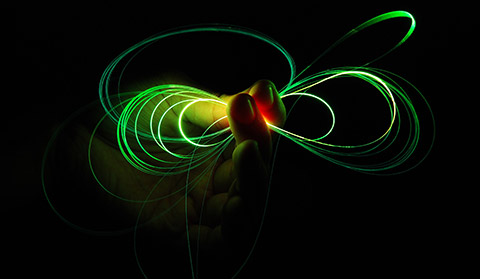University of Southampton experts investigate manipulating light at the submicroscopic level
A team of researchers led by the University of Southampton has shown light can be moved within a distance which is smaller than its own wavelength – a level of unprecedented precision.
Scientists from Southampton, together with the universities of Dortmund and Regensburg in Germany, have demonstrated that a beam of light can not only be confined to a spot which is 50 times smaller than its own wavelength, but that also – in a first of its kind – the spot can be moved by miniscule amounts at the point where the light is confined.
The detailed findings of their theoretical study are published in the journal Optica.
Confining and controlling light on ever smaller volumes is one of the defining challenges in modern photonics; the science behind the generation, detection and manipulation of light. How tightly the light is confined determines the limits for the observability of nanoparticles, as well as the intensity and the precision of light-based devices.
One example is optical tweezers. These are widely used in laboratories around the world in fields such as that of DNA research. They consist of highly focused laser beams that trap, manipulate and move particles with astounding precision. One of the limitations with standard optical tweezers is that lenses cannot focus beams on lengths much smaller than the laser beam’s own wavelength, limiting the achievable precision.
Study author and Research Fellow at the University of Southampton’s Quantum, Light and Matter Group, Erika Cortese explains: “By its nature, light is indeed very difficult to localise on a smaller length scale than its wavelength, a critical threshold known as the Abbe limit. However, using a sophisticated model and numerical simulation, we have successfully demonstrated a novel approach to localise and dynamically manipulate light at a sub-wavelength scale.”
The research collaboration was led by Professor Simone De Liberato, leader of the Quantum Theory and Technology group in the School of Physics and Astronomy at Southampton. He says: “We believe our novel approach to actively control confined electromagnetic fields could have high-impact consequences across multiple nanophotonic applications.
“Looking to the future, in principle, it could lead to the manipulation of micro and nanometre-sized objects, including biological particles – or perhaps the sizeable enhancement of the sensitivity resolution of microscopic sensors.”
The scientists hope that with further research they can eventually open the way to more advanced manipulation techniques, such as the sorting and rational assembly of nanoparticles, employed in biology, chemistry and soft matter research.

